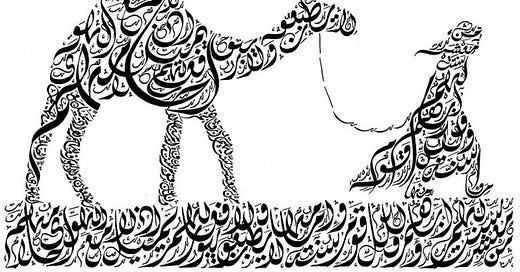🌟 Meeting Labīd Ibn Rabīah In Heaven: 1/3
Journey Through Abū al-ʿAlāʾ al-Maʿarrī's Risalat Al Ghufraan & The Characters Ibn Qarih Meets in Heaven [Dante before Dante].
I have grown weary of life & it's length,
and hearing people's [incessant] question “O How are You Labīd?”
[The way Arabic Poetry goes itself makes the couplet all the more beautiful. Arab tradition was all Oral, and not at all written. So their definition of harmony was all that can be said equally in balance & not written.
So occasionally, as we’ll see in further posts, seemingly totally unequivalent and unmetrical couplets will be posted which when “Spoken” balance harmoniously to give the most beautiful of meanings. i.e Depth Beyond Belief.]
============================================================================
More On The Verse:
[Breakdown of the verse for more interested readers :)]
============================================================================
This verse consists of two hemistichs (شطران), following a structured classical poetic format.
Eloquence (بلاغة): We find a contrast between the length of life and the repetitiveness of people's questions.
Direct rhetorical question ("كيف لبيد"), adds (ضرب 🥊) emphasis.
Meter: Whole section on this below
🟢 Exact Meanings of Arabic in Context:
- وَلَقَدْ
وَ: Conjunction ("and").
“لَقَدْ”: Used for emphasis, often translates to "indeed" or "surely."
Meaning: "And indeed..."
- سَئِمْتُ
From “س-ء-م”, meaning to become weary, bored, or exhausted.
Meaning: "I have grown weary..."
- مِنَ الحَيَاةِ وَطُولِهَا
الحياة: Life.
طُولِهَا: Its length.
Meaning: "Of life and its length."
The poet finds life excessively long and burdensome.
- وَسُؤَالِ هَذَا النَّاسِ
وَ: Conjunction ("and").
سُؤَالِ: From “س-ء-ل”, meaning “Inquire”
هَذَا النَّاسِ: These people.
Meaning: "And (of) the questioning of these people..."
- كَيْفَ لَبِيدٌ؟
كَيْفَ: How?
لَبِيدٌ: The poet's name (Labīd).
Meaning: "How is Labīd?"
Implication: People repeatedly ask how he is, further adding to the intemperance.
🔵 Intricacies of the Verse:
Themes in the couplet range from
expresses fatigue with life itself,
A melancholic reflection on aging and social expectations.
The phrase "طولها" suggests not just the passage of time, but an unbearable extension of existence.
The Burden of Social Repetition
constant asking, "كيف لبيد؟"
Just a tiresome cycle of social interactions, where nothing ever changes.
This is a common theme in late-life Arabic poetry, where poets express disillusionment with the world.
🔘 Root Analysis and Classical Usage:
For the words used, find a comparative analysis of their roots as used throughout the Evolution of Arabic Language. I’ve tried therein to include verses for reference. The whole story of Arabic Dictionaries is fascinating in of itself too. Godbless.]
[The distinctive time-lines of Arabic of course being can be found here1] [See footnote].
[Notes on the References used, of course can be found here2] [See footnote].
🟡 Identifying the Meter (البحر الشعري)
The pattern closely matches al-Ṭawīl (الطويل), one of the most famous Arabic poetic meters. In Arabic, Unlike English, the meter is determined by Length of The Syllable & not on its Strength. The same is the case with poetry of Classical Greek & Hebrew.
The default pattern of بحر الطويل is:
فَعُولُنْ مَفَاعِيلُنْ فَعُولُنْ مَفَاعِلُنْ
فَعُولُنْ مَفَاعِيلُنْ فَعُولُنْ مَفَاعِلُنْ
Each hemistich follows this structure i.e The Amount of Syllables constraint in this line i.e (On the weight of this default pattern).
However, classical Arabic poetry allows certain permissible variations (الزحافات والعلل).
Applying the Pattern to Labīd's Verse:
First Hemistich:
وَلَقَدْ سَئِمْتُ مِنَ الحَيَا وَطُولِهَا
Taqṭīʿ (Scansion) into Feet would go as,
وَلَقَدْ سَئِمْتُ مِنَ الْحَيَا وَطُولِهَا
فعولن مفاعيلن فعولن مفاعلن
Second Hemistich:
وَسُؤَالِ هَذَا النَّاسِ : كَيْفَ لَبِيدُ
Taqṭīʿ (Scansion) into Feet would go as,
وَسُؤَا لِ هَذَا النَّاسِ كَيْ فَ لَبِيدُ
فعولن مفاعيلن فعولن مفاعلن
Observed Metrical Variations (الزحافات والعلل):
1. مفاعيلن → مفاعلن (ʿIlla: ʿAsab محذوفة)
In the last foot of each hemistich, مفاعيلن is shortened to مفاعلن by dropping the final long syllable.
This is a common variation in al-Ṭawīl in Pre-Classical Arabic Poetry, making it more rhythmically dynamic. [It is Allowed :D]
The same pattern is followed in both halves of the verse, ensuring metrical harmony.
Time Period Division for Arabic Language Evolution:
Pre-Islamic (Jāhilī) | Before 610 CE | Language of the pre-Islamic Arabs, oral poetry, and tribal dialects.
Classical Arabic | 610 CE – 1258 CE | Language of the Qurʾān, Hadith, and literary texts of Al-Jāḥiẓ and Sibawayh.
Post-Classical Arabic | 1258 CE – 1800 CE | Decline in linguistic purity, Persian and Turkish influences.
Modern Standard Arabic (MSA) | 1800 CE – Present | Standardized, formal Arabic used in media, education, and literature.]
On The Dictionaries:
Lisān al-ʿArab (ابن منظور, d. 1311 CE) → One of the most comprehensive dictionaries, covering roots across different eras.
Tāj al-ʿArūs (الزبيدي, d. 1790 CE) → A refinement and expansion of Lisān al-ʿArab, focusing on classical and post-classical Arabic.
Maqāyīs al-Lugha (ابن فارس, d. 1005 CE) → Breaks roots into their fundamental conceptual meanings, showing how words evolved.
Al-Muḥkam wal-Muḥīṭ (ابن سِيده, d. 1066 CE) → Focuses on the linguistic rules governing word formation.
Ṣiḥāḥ al-Lugha (الجوهري, d. 1003 CE) → Early lexicon emphasizing proper usage in Arabic poetry and grammar.





